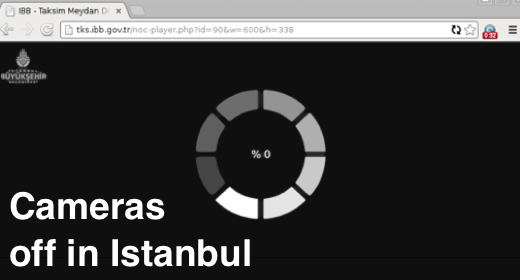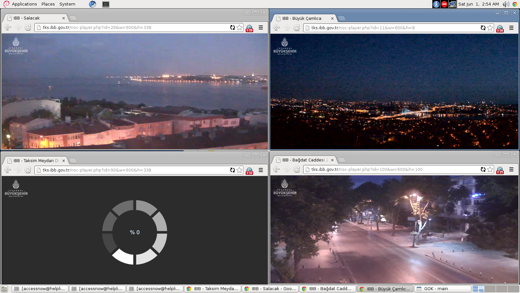
Gustaf Bjorksten, Al Walid Chennoufi, and Mohamed Chennoufi contributed to this post.
As Istanbul’s Taksim Square swelled with protesters on Friday night, local authorities seemingly disabled livestreams from the municipality’s ‘Turistik Kameralar,’ or Tourist Cameras, that showed views of the plaza. By scraping the feed, Access was able to identify when the camera was disabled, as well as evidence that seems to prove that the feeds were disabled deliberately, rather than collapsing under ‘viewer load.’
Protests began last Monday, after bulldozers began removing trees from Gezi Park, one of the few remaining open green spaces in Istanbul’s city core, in order to clear the land for the development of a shopping mall. Protesters identifying as environmentalists began a sit-in, soon drawing support from other groups, including unions, leftist groups, and opposition parties, as the peaceful demonstration took on an anti-government tone with frustration directed at Turkey’s long-governing Prime Minister Recep Tayyip Erdogan and his AK Party.
On Friday morning, police raided the park, setting off a day-long confrontation that drew in thousands of additional protesers, as authorities turned water cannons and tear gas on demonstrators. As scenes of violence emerged, protests began in Turkey’s capital, Ankara, with additional demonstrations called for the in cities of Bodrum, Izmir, and Konya.
On Friday afternoon, reports began circulating that the government was turning off its tourism-oriented live feeds from above the square in an effort to control the outflow of scenes of violence against protesters. Access began monitoring these feeds late Friday afternoon, and found evidence of interference when the cameras went dark beginning at 22:52 EEST (local time).
Each of the ‘Tourism Cameras’ multiple live webcam feeds are delivered to the web from the same main server. At the time of the outage, traces to this server showed a roughly 300 millisecond increase in ‘latency,’ or delayed delivery. Although this is slower than normal feeds, and does indicate a higher ‘load,’ or greater numbers of users streaming the feed, this should not be sufficient to cause an outage. And despite the slight delay, other feeds from around the city, offering views of the city’s expansive skyline, coasts, and historical sites, remained online, despite those streams being delivered from the same server as the Taksim cameras.

As of mid-day local time on Sunday, the Taksim webcam remained offline, even though trace times had returned to their pre-outage levels: roughly 150 milliseconds between when the trace left the Access server, pinged the webcam server, and returned to our servers. Furthermore, cameras from the neighboring area of Istiklal have also been disabled since Access began monitoring. Istiklal–one of the country’s best known public avenues, and a main pedestrian artery into Taksim–has been filled with protesters, tear gas, and police since mid-Friday.
Unconfirmed reports have been circulating about internet and mobile phone outages in areas nearby the square. Access has been unable to substantiate these reports in a manner that would indicate whether these outages were a result of government interference, or merely network strain under unusually large traffic loads. We will continue to monitor the situation, and if you have additional evidence, please be in touch at info [at] accessnow [dot] org.

Update 06/04/13: Nearly three days after the tourist webcams in Taksim Square were first disabled, all the tourist webcams across the entire Istanbul cityscape were disabled. On Monday at at 16:40, a single word message appears in place of the webcam streams claiming the webcams have been disabled for “maintenance.”